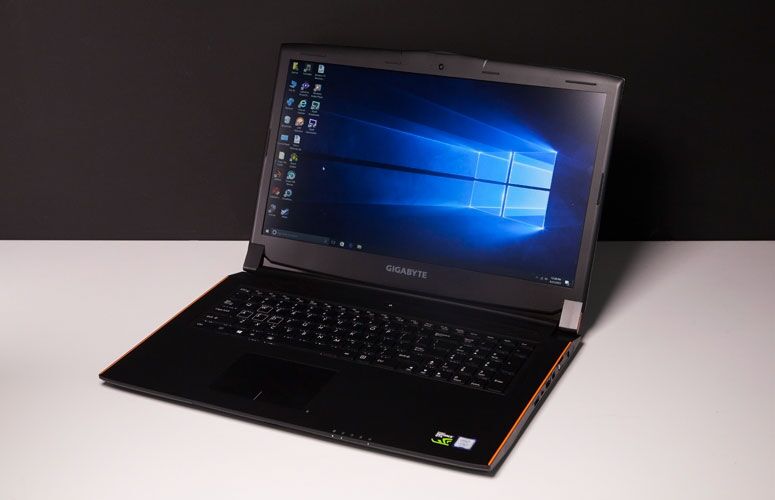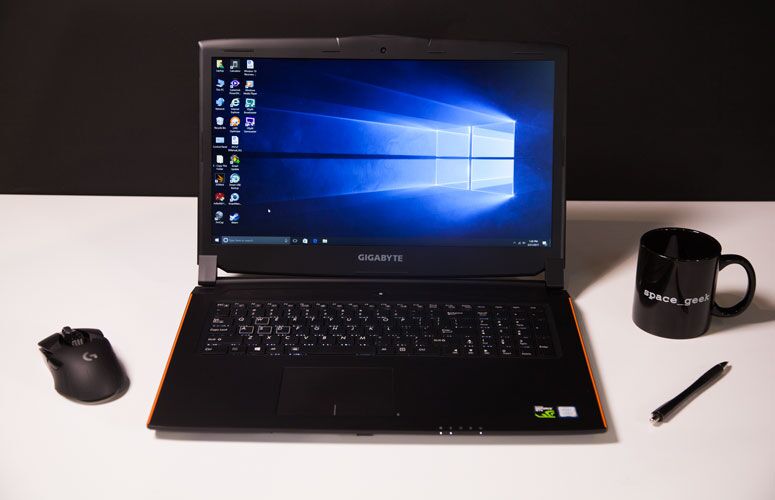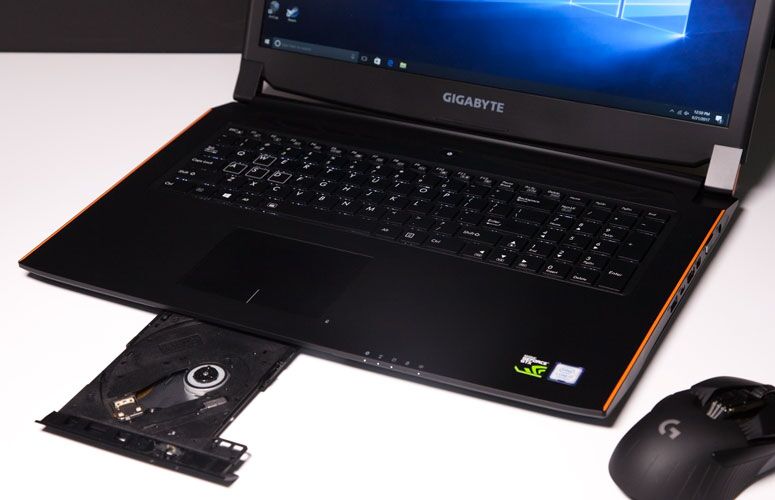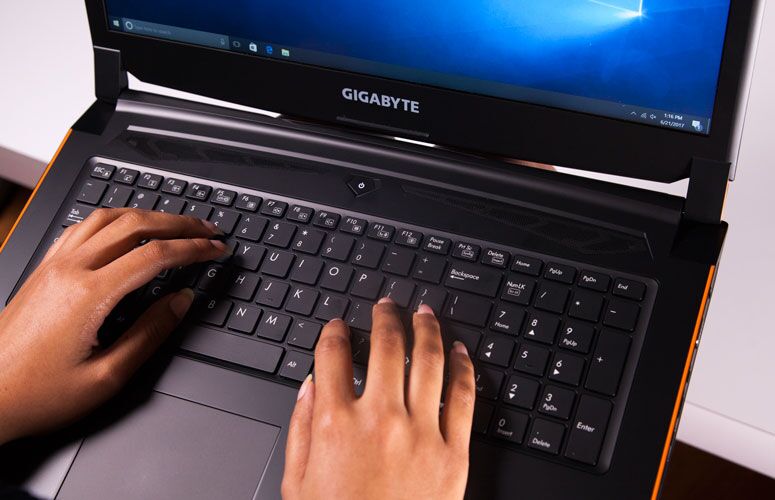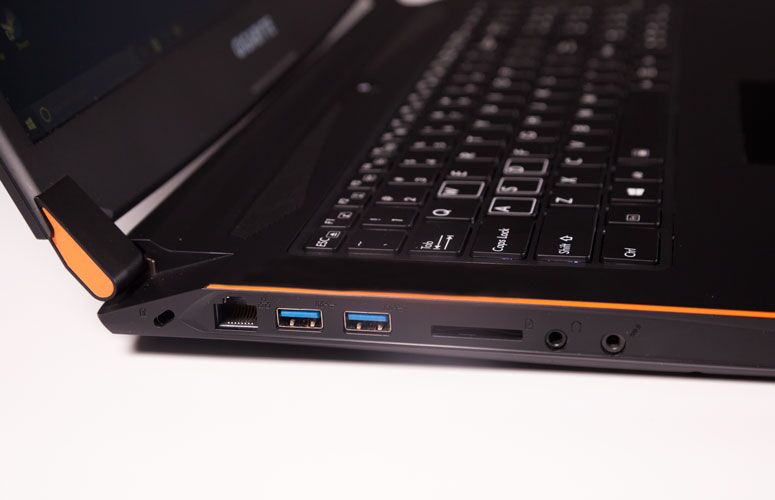Laptop Mag Verdict
The Gigabyte P57Xv7 delivers a big and colorful screen and strong gaming performance in a sleek design, but the audio could be better.
Pros
- +
Good price for the specs
- +
Bright, accurate panel with great refresh rate
- +
Swappable optical drive
Cons
- -
Below-average battery life
- -
Lackluster audio
Why you can trust Laptop Mag
Who says you can't have it all? Or at least close to it. The 17.3-inch Gigabyte P57Xv7 (starting at $1,599, or $1,999 as reviewed) combines graphics might and portability into a stylish chassis. Powered by an Intel Core i7 processor and an Nvidia GeForce GTX 1070 GPU, the P57Xv7 can do it all: gaming, productivity and VR. However, with less than 3 hours of battery life, you might want to keep your gaming travels local.
Design
It looks like Gigabyte is taking a few pages from its sister brand, Aorus. The P57Xv7 isn't the hulking mass of plastic that I'm used to seeing from a 17-inch desktop replacement. Instead, the P57Xv7 is all clean, delicate lines with a dollop of color for good measure. The black plastic lid is devoid of any real decoration outside of the gleaming, chrome Gigabyte emblem at the center. But it's those subtle touches I really appreciate, like the pair of darts at the bottom of the lid or how the top of the lid forms into a rounded point like an arrowhead worn down by time.
The laptop's interior is rather plain outside of the thin, tangerine stripes on the sides and the top-mounted speaker that flares out at ends. The pentagonal power button sits in between the vents, right above the keyboard in its recessed deck. The touchpad beneath the keys is almost as massive as the palm rest housing it.
You need ports, and the P57Xv7 has plenty. Along the right, you'll find a USB 3.0 port, USB Type-C, HDMI, mini DisplayPort, VGA and the power jack. A pair of USB 3.0 ports sit on the left with an SD card reader, Gigabit Ethernet, jacks for a microphone and pair of headphones, and a Kensington lock.
But the laptop has a secret squirreled away at the front of the system. If you press the button on the bottom lip of the P57Xv7, it reveals a DVD player. If physical discs aren't your thing, you can swap out that optical drive for a hard drive of up to a 2TB. This can come in handy for some of the larger games like Mass Effect: Andromeda, which requires 49.2GB of space.
Thanks to the 120-hertz refresh rate, I could play games at maximum settings and still get smooth graphics at high frame rates.
At 7.2 pounds and 16.7 x 11.4 x 1.1 inches, the P57Xv7 isn't the slimmest desktop replacement out there -- the Razer Blade Pro (7.8 pounds, 16.7 x 11 x 0.88 inches) holds that honor. The P57Xv7 is definitely the lightest, especially compared to hefty systems like the Alienware 17 R4 (9.6 pounds, 16.7 x 13.1 x 1.2 inches), Origin Eon17-X (9.8 pounds, 16.4 11.6 x 1.6 inches) and Asus ROG G752VS OC Edition (10 pounds 16.4 x 12.7 x 1.9 inches)
Sign up to receive The Snapshot, a free special dispatch from Laptop Mag, in your inbox.
Display
Watching the Tears of Steel trailer on the P57Xv7's 17.3-inch, 2560 x 1440 panel was a treat. My eyes were immediately drawn to the fluorescent pinks and blues in the lead actors' clothing as it popped against their black leather jackets. Crisp detail revealed some of the smaller gears and screws in the actress's robot hand as she gesticulated angrily at her partner.
Games like Mass Effect Andromeda are just as pretty on this panel, as I landed on my first colonizable world and peered upward at the clear blue sky spread over the burnt-sienna landscape. The wide treads from my intergalactic ATV gripped the harsh earth, leaving clean imprints as I began exploring. Thanks to the 120-hertz refresh rate, I could play games at maximum settings and still get smooth graphics at high frame rates.
The P57Xv7's panel is vivid, registering 112 percent of the sRGB color gamut. That was enough to match the G752VS's showing and is comparable to the Alienware 17's results (113 percent). The Blade Pro (185 percent) and Eon17-X (192 percent) turned in even higher scores, however.
The laptop delivered admirable performance on our various gaming benchmarks.
The screen on the P57Xv7 is also pretty accurate. It notched a Delta-E rating of 0.2 (0 is ideal), which is better than the 1.3 average as well as the showings by the Alienware 17 (0.5), Blade Pro (2.3) and G752 (2.1). The Eon17-S was a smidge better, with 0.14.
Despite its matte display, the P57Xv7 is nice and bright, averaging 314 nits, topping the 290-nit average. Only the Alienware and G752 were brighter, at 340 and 476 nits, respectively.
Audio
The front-firing speakers on the P57Xv7 aren't as powerful as I would have hoped. Even with the Dolby Digital Plus software enabled, the synths and the bass on Tank and the Bangas' "Quick" was submerged beneath the keyboard. The vocals, while clear, barely filled our lab.
The underwhelming performance continued as I played Mass Effect: Andromeda. Blowing up an explosive canister in a crowd of enemies didn't have the depth of sound that I've gotten used to on other systems. The dramatic battle music was muted, especially the swelling strings.
Keyboard and Touchpad
With a key travel measuring 1.5 millimeters and 63 grams of actuation, the P57Xv7's island-style keyboard is a bit on the mushy side. However, I was able to maintain my usual typing speed, easily hitting my 65 word-per-minute average on the 10FastFingers typing test.
The 4.2 x 3.0-inch Elan touchpad offers plenty of space for my fingers to navigate through a rather long document or perform a few multitouch gestures. The smooth surface delivered a fast, accurate response to my input.
Gaming, Graphics and VR
The P57Xv7 has some serious firepower under the hood, thanks to its Nvidia GeForce GTX 1070 GPU with 8GB of VRAM. That means the system will consistently notch high frame rates even on high settings. Even better, you can hook up an Oculus Rift or HTC Vive and see what all this VR hubbub is about.
The laptop delivered admirable performance on our various gaming benchmarks. It hit 50 frames per second on the Rise of the Tomb Raider benchmark (1080p on high), matching the Alienware 17, but falling a little short of the 53-fps average. The Asus G752, Blade Pro and Eon17-X all scored higher than 60 fps.
On the Hitman test, the P57Xv7 racked up 76 fps, missing the 81-fps category average. The Alienware, G752, Blade Pro and Eon17-X all scored higher, at 89 fps, 91 fps, 103 fps and 129 fps.
The Gigabyte lasted only 2 hours and 36 minutes on our battery test.
When we switched over to the Grand Theft Auto benchmark, the P57Xv7 scored 72 fps, beating the 70-fps average and the Blade Pro's score. The G752 did slightly better, at 73 fps, while the Alienware and Eon17-X achieved 82 and 84 fps.
If you decide to take a break from gaming, the notebook will switch over to its integrated Intel HD Graphics 630 GPU.
Performance
Outfitted with a 2.8-GHz Intel Core i7-7700HQ processor with 16GB of RAM, the P57Xv7 is just as powerful when it's running spreadsheets as when it's gaming. I watched an episode of Insecure on HBO Now with 20 open Google Chrome tabs (some of which had Twitch, TweetDeck or Slack running) and Windows Defenders scanning things in the background. The system chugged along without any trace of latency.
On the Geekbench 4 synthetic performance test, the P57Xv7 scored 12,387, beating the Blade Pro (2.6-GHz Intel Core i7-6700HQ CPU), which hit 11,702, but not the 12,795 desktop-replacement average. Systems with overclockable processors -- like the Alienware, Eon17-X and G752 -- scored higher than 14,000.
When we ran the OpenOffice Spreadsheet Macro test, the P57Xv7 matched 20,000 names and addresses in 3 minutes and 38 seconds, which is slower than the 3:26 average, but still better than the Eon17-X's and the Blade Pro's times. The G752VS and the Alienware 17 both took under 3 minutes.
The P57Xv7's 256GB M.2 SSD (and 1TB 7,200-rpm hard drive) duplicated 4.97GB of mixed-media files in 36 seconds for a transfer rate of 137 megabytes per second, which is far below the 531.3 MBps average.
Keep in mind, however, that other laptops in this category are outfitted with faster PCie SSDs.
Battery Life
The Achilles' heel of most gaming laptops is their battery life, and the P57Xv7 is no different. The laptop lasted only 2 hours and 36 minutes on our test (continuous web surfing over Wi-Fi). That's shorter than the 4:27 average and the G752's time of 3:53.
Heat
After we let the system cool down, we streamed 15 minutes of HD video. When it was done, the touchpad produced a chilly 76 degrees Fahrenheit. The bottom and the space between the G and H keys were somewhat warmer, at 83 and 87 degrees, respectively, but still below our 95-degree comfort threshold..
Webcam
The P57Xv7's 720p webcam takes mighty grainy images. While I could make out some of the more pronounced details in my test shots, like the folds in my shirt, all the lights in the picture were blown out. The color was also off, as my red shirt looked a couple of shades darker than it actually was, as did the purple in my hair.
Software and Warranty
Gigabyte has preloaded a few helpful utilities on the P57Xv7, such as Smart Manager for quick access to system settings like brightness, volume, fan speed and Bluetooth. Smart Update keeps track of all your updates for your apps and hardware components. You also get Smart USB Backup, which you can use to create a file backup that can be stored on an available USB drive. There's also the LAN Optimizer, that lets you prioritize which programs get the fastest broadband access.
Third-party gamer-focused software includes Nvidia GeForce Experience, which offers a small suite of apps designed to optimize your gameplay. The system also has XSplit Broadcaster and Gamecaster in case you feel like streaming or recording your gaming antics.
Unfortunately, the P57Xv7 does have a fair share of bloatware, including Sling TV, Twitter, Royal Revolt, March of Empires: War of Lords and Candy Crush Soda Saga, to name a few.
Configurations
I reviewed the $1,599 configuration of the P57Xv7, which has a 2.8-GHz Intel Core i7-7700HQ processor with 16GB of RAM, a 256GB M.2 SSD with a 1TB 7,200-rpm hard drive, an Intel HD Graphics 630 GPU, an Nvidia GeForce GTX 1070 GPU with 8GB of VRAM and a 2560 x 1440 display with a 120-Hz refresh rate. The $1,599 base model offers similar specs, but has a less powerful GTX 1060 GPU and an FHD (1920 x 1080) display instead of QHD.
Bottom Line
The Gigabyte P57Xv7-KL3K3 gets a lot of things right. It's slim, light design makes it one of the few portable desktop replacements on the market. The system's QHD display is bright, accurate and plenty vivid, and thanks to its Core i7 processor and Nvidia GTX 1070 GPU, this machine can keep pace with the big boys. And I'm a big fan of swappable drives. However, for $1,999, I want better battery life and audio quality.
If your budget can bear it, I'd recommend the $2,499 Asus ROG G752VS OC Edition. This bad boy has power to spare with its overclocked components and blistering-fast PCIe SSD. But you'd be sacrificing any hope of portability. Overall, if you're looking for a gaming laptop with good performance and a lovely display, the P57Xv7 is worth a look.
Credit: Keith Agnello/Laptop Mag
Gigabyte 57v7 Specs
| Bluetooth | Bluetooth 4.2 |
| Brand | Gigabyte |
| CPU | 2.8-GHz Intel Core i7-770HQ processor |
| Card Slots | SD memory reader |
| Company Website | www.gigabyte.us |
| Display Size | 17.3 |
| Graphics Card | Nvidia GeForce GTX 1070/Intel HD Graphics 630 |
| Hard Drive Size | 256GB |
| Hard Drive Speed | n/a |
| Hard Drive Type | PCIe m.2 SSD |
| Highest Available Resolution | 2560 x 1440 |
| Native Resolution | 3840 x 2160 |
| Operating System | Windows 10 Home |
| Optical Drive | CD Burner/DVD Combo Drive |
| Optical Drive Speed | 8X |
| Ports (excluding USB) | Kensington Lock, Headset, VGA, HDMI 2.0, USB Type-C, Gigabit Ethernet, USB 3.0, Mini DisplayPort, Microphone |
| RAM | 16GB |
| Secondary Hard Drive Size | 1TB |
| Secondary Hard Drive Speed | 7200 |
| Secondary Hard Drive Type | SATA Hard Drive |
| Size | 16.7 x 11.4 x 1.1 inches |
| USB Ports | 4 |
| Video Memory | 8GB |
| Weight | 7.2 pounds |
| Wi-Fi | 802.11ac |
| Wi-Fi Model | Intel(R) Dual Band Wireless-AC 8260 |

Sherri L. Smith has been cranking out product reviews for Laptopmag.com since 2011. In that time, she's reviewed more than her share of laptops, tablets, smartphones and everything in between. The resident gamer and audio junkie, Sherri was previously a managing editor for Black Web 2.0 and contributed to BET.Com and Popgadget.
